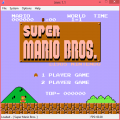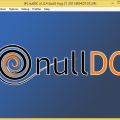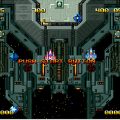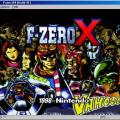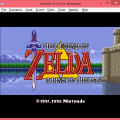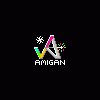- 0 replies
- 1,804 views
- Add Reply
- 0 replies
- 1,914 views
- Add Reply
- Joystick support through both Direct Input and xInput (thanks Zlika)
- Supports Mapper 0, 1, 2, 3, 4, 5, 7, 9, 10, 11, 15, 19, 21, 22, 23, 24, 25, 26, 33, 34, 38, 41, 48, 58, 60, 61, 62, 64, 65, 66, 67, 68, 69, 70, 71, 72, 73, 75, 76, 78, 79, 86, 87, 88, 89, 92, 93, 94, 97, 107, 112, 113, 118, 119, 140, 152, 154, 180, 182, 185, 200, 201, 203, 206, 212, 213, 214, 225, 226, 229, 231, 240, 241, 242, 244, 246, 255
- SRAM save support (no save states however)
- Game Genie and Action Replay cheat code support
- Accurate sound core
- Fast video code with NTSC filter (filter is still slow)
- Full screen support
- Cross-platform portable
- Added options dialog for remapping of keys
- Added support for NSF music files. (All expansions are supported except FDS.)
- Added mapper for Super Spike V'Ball/Nintendo World Cup combo cartridge
- Changed sprite DMA timings (fixes Battle Chess again)
- 0 replies
- 2,388 views
- Add Reply
- 0 replies
- 2,802 views
- Add Reply
2013-09-13 Recent Releases

An exceptionally quiet week...
fceux r2994 - http://www.fceux.com/web/download.html
jpcsp r3376 - http://www.jpcsp.org/
MAME Plus Extended 0.149u1r5088 - http://www.emulab.it/p_emulators.php
mGalaxy v5.0 released
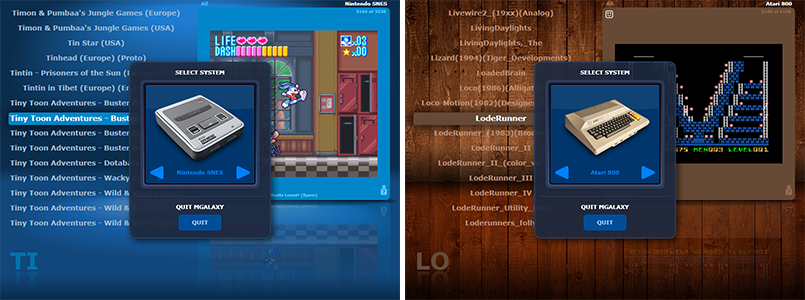

Hours and hours in development, a lot of additions, listening for (nearly) every users wishes, making mGalaxy more opened, more practical,...more powerful.
New and updated in this release:
--------------------------------
• : Xbox 360 controller support.
• : Vertical (portrait) theme support.
• : Database support extended to all systems.
• : Multiple extensions support.
• : mGalaxy is now “portable”.
• : Clock display added.
• : “Filtering on Players” notification icon added.
• : New key added: ‘Info window’
• : New key added: ‘Pick a random game’
• : Change in the way AutoIt scripts are used.
• : mGalaxy_Runway: “Exclusion Words” field.
• : mGalaxy_Runway: new “Use database file (if available)” button.
• : mGalaxy_Runway: new “Import database file” button.
• : mGalaxy_Runway: new “Use script file (if available)” button.
• : mGalaxy_Runway: last folder kept in memory.
... Note that since v4.0 mGalaxy is multi-emulator compatible!
Spread the news !!
More info and download on http://www.mgalaxy.com
halfnes 055 released
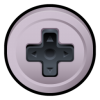
Description:
HalfNES is an open-source emulator for the Nintendo Entertainment System, written in Java. Currently, it is available as a standalone Java SE application.
Current Features:
Change log:
nGlide 1.02 released
nGlide is a freeware Glide wrapper for Windows and DOS games. It allows you to play 3Dfx games on modern GeForce/Radeon graphics cards. Some of them are Diablo 2, Need for Speed 2-5, Carmageddon 2, Tomb Raider, Turok. All three API versions are supported, Glide 2.1 (glide.dll), Glide 2.4 (glide2x.dll) and Glide 3.0 (glide3x.dll). Glide wrapper also supports high resolution modes.
nGlide 1.02 changelog:
Glide2:
-added support for Battlecruiser 3000AD 2.0 (with DOSBox + Gulikoza's patch)
-added support for Extreme Assault (with DOSBox + Gulikoza's patch)
-added support for F1 Racing Simulation
-added support for Falcon 4.0
-added support for Future Cop L.A.P.D.
-added support for Grand Prix Legends
-added support for Jane's Combat Simulations: AH-64D Longbow Gold
-added support for Monaco GP Racing Simulation 2
-added support for Monaco GP Racing Simulation 2 (Demo)
-added support for Tie Break Tennis (with DOSBox + Gulikoza's patch)
-fixed Carmageddon (with DOSBox + Gulikoza's patch) glitches in 3dfx.exe version
-fixed CyberStrike 2 missing HUD elements
-fixed Hexen 2 missing loading bars
-fixed Hexen 2: Portal of Praevus missing loading bars
-fixed Joint Strike Fighter internal resolution switching crash
-fixed Lands of Lore 2 (with DOSBox + Gulikoza's patch) blinking cursor
-fixed NHL 99 loading screen glitch
-fixed POD Gold grSstWinOpen error with videos enabled
-fixed Rayman 2: The Great Escape internal resolution switching crash
-fixed Return Fire 2 glitches
-fixed Star Wars: Rogue Squadron 3D crash in 800x600
-fixed Test Drive 4 blinking esc menu
-fixed Test Drive Off-Road 2 blinking esc menu
-fixed Trophy Bass 3D ctd at exit
-fixed Trophy Bass 4 ctd at exit
Glide3:
-added support for American McGee's Alice
-added support for Heavy Metal: F.A.K.K. 2
-added support for MDK 2
-added support for Quake 3 Arena
-added support for Serious Sam: The First Encounter
-added support for Serious Sam: The Second Encounter
-added support for Soldier of Fortune
-added support for Star Trek: Elite Force 2
-added support for Tiger Woods PGA TOUR 2001
-added support for Quantum3D splash plugin
-fixed Divine Divinity broken fog
-fixed NHL 2000 slow interface and missing special effects
-fixed NHL 2001 slow interface and missing special effects
-fixed NHL 2002 slow interface and missing special effects
-fixed Pro Rally 2001 crash in 800x600
Miscellaneous:
-improved performance of lfb and texture operations
Glide wrapper download:
http://www.zeus-software.com/downloads/nglide
Source:
http://www.zeus-software.com/forum/viewtopic.php?f=2&t=621

